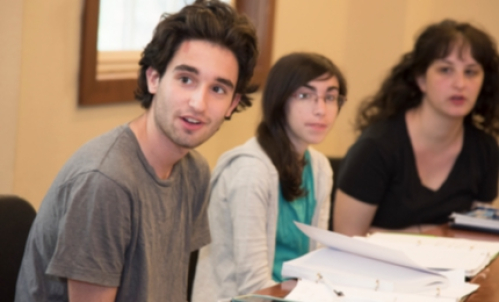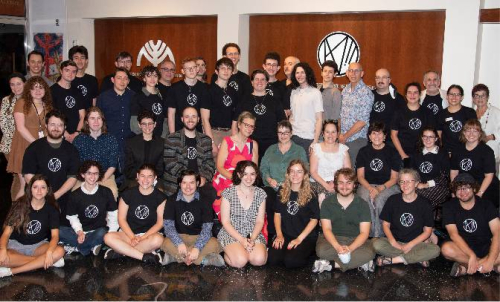YIVO Mounts New Exhibition | Palestinian Yiddish: A Look at Yiddish in the Land of Israel Before 1948
(New York, NY) – The YIVO Institute for Jewish Research (YIVO) is pleased to announce the opening of its newest on-site exhibition on September 5, 2023, Palestinian Yiddish: A Look at Yiddish in the Land of Israel Before 1948.
Palestinian Yiddish will be on view at YIVO located in the Center for Jewish History building (15 West 16 Street, New York, New York) for the fall of 2023. The exhibition explores the importance of language and national identity as key elements of Jewish history and culture.
Yiddish has been a feature of Jewish life in Palestine much longer than people imagine and there is evidence that Yiddish was spoken in the Holy Land as early as the 16th century. What is more, Ashkenazi communities living in Palestine spoke a unique dialect of Yiddish, with many words and phrases absorbed from Arabic, the dominant language in the then Ottoman-ruled region.
“Yiddish could be heard in the streets of Jerusalem, Tsfat, and Tiberias long before Zionism was even a twinkle in Theodor Herzl’s eye,” said exhibition curator Eddy Portnoy, who is YIVO’s Academic Advisor and Director of Exhibitions.
Yet the rise of Zionism in the late 19th century and an increase in Jewish immigration to the Land of Israel brought about a different attitude towards Yiddish. Zionism began developing a new, modern Hebrew culture to replace diaspora Jewish cultures.
Hoping to break with the past, early Zionist ideology was very much opposed to Yiddish culture and actively suppressed it. The new “muscular Judaism” of Zionism was created in contrast to the allegedly weak diaspora Jews, who were associated with Yiddish, the most broadly spoken Jewish language worldwide.
Some Zionists actively combatted Yiddish through propaganda, protests, and violence, while Zionist Yiddishists were in the process of creating a new type of Palestinian Yiddish culture. This Palestinian Yiddish literature forms the core of this exhibit.
After the declaration of the state in 1948, Yiddish continued to be legislated against. While Zionism succeeded in creating a Hebrew-speaking country, it did so at the expense of the heritage language of many of its first citizens.
“Because modern Hebrew was created by Yiddish speakers, much of Hebrew phraseology is based on Yiddish linguistic constructions,” added Portnoy.
“Yiddish could be heard in the streets of Jerusalem, Tsfat, and Tiberias long before Zionism was even a twinkle in Theodor Herzl’s eye,” said exhibition curator Eddy Portnoy, who is YIVO’s Academic Advisor and Director of Exhibitions. “While the official language of Israel is Hebrew, there is still quite a lot of Yiddish behind the scenes.”
Quotes
“Yiddish, the language that European Jews spoke for over a thousand years, was an integral component of the Hebrew used by the Zionist culture of Palestine in the early twentieth century,” said Yael Chaver, Lecturer Emerita in Yiddish at the University of California, Berkeley, and author of What Must Be Forgotten: The Survival of Yiddish in Zionist Palestine.
The unique Yiddish press and literature that emerged did not always see eye to eye with Zionist ideology and was mostly ignored – if not proscribed. In a twist of historical irony, the current wave of renewed interest in Yiddish worldwide includes Israel as well, with Yiddish classes available and popular everywhere,” said Chaver.
“This exhibit introduces yet another, largely unknown arena of Yiddish culture, which enriches our concept of Yiddish land: wherever Yiddish is spoken,” said Chaver.
“It is high time that a Jewish institution address the issue of Zionism’s linguicide (language killing) attempt against Yiddish and I commend YIVO for mounting this fascinating and multifaceted exhibition. Having absorbed the disdain for Yiddish generated by the 19th century Jewish Enlightenment, Zionist ideologues actively persecuted the language in spite of, often inadvertently, exploiting it to fill gaps in the new “Israeli” language they were creating,” said Professor/Dr. Ghil'ad Zuckermann, author of the seminal book Revivalistics (Oxford University Press, New York).
Find out more about the exhibit.
For any media inquiries please contact:
Shelly Freeman
Chief of Staff
YIVO
The YIVO Institute for Jewish Research is dedicated to the preservation and study of the history and culture of Eastern European Jewry worldwide. For a century, YIVO has pioneered new forms of Jewish scholarship, research, education, and cultural expression. Our public programs and exhibitions, as well as online and on-site courses, extend our global outreach and enable us to share our vast resources. The YIVO Archives contains more than 24 million original items, and YIVO’s Library has over 400,000 volumes—the single largest resource for such study in the world. yivo.org / yivo.org/the-whole-story

